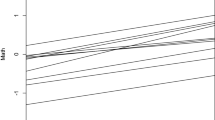Abstract
Variance components in the context of Generalizability Theory are useful indices for attributing the amount of variance to a particular facet or object of measurement. The mean difference effect size (MDES) has proven to be a useful tool both in synthesizing the results of multiple studies and in interpreting individual study results. A mathematical relationship is drawn, therefore, between the variance components of a nested two-facet design configuration on the one hand, and the MDES that can be calculated from the descriptive statistics of an hypothetical measurement study on the other. Using two different variance components estimation procedures, we show that the relationship is both statistically and conceptually meaningful in that all of these estimates closely approximates the true Glassian MDES.
Similar content being viewed by others
References
Boodoo, G. M. (1982). On describing an incidence sample. Journal of Educational Statistics, 7, 311–331.
Brennan, R. L. (1992a). Elements of generalizability theory. Iowa City, IA: American College Testing.
Brennan, R. L. (1992b). Generalizability theory. Educational Measurement: Issues and Practice, 11, 27–34.
Cardinet, J., & Allai, L. (1983). Estimation of generalizability parameters. In L. J. Fyans, Jr. (Ed.), Generalizability Theory: Inferences and Practical Applications. New Directions for Testing and Measurement, 18, 17–48. San Francisco: Jossey-Bass.
Carver, R. P. (1978). The case against statistical significance testing. Harvard Educational Review, 48, 378–399.
Carver, R. P. (1993). The case against statistical significance testing, revisited. Journal of Experimental Education, 61, 287–292.
Cohen, J. (1988). Statistical power analysis for the behavioral sciences. Hillsdale, NJ: Lawrence Erlbaum Associates.
Crocker, L., & Algina, J. (1986). Introduction to classical and modern test theory. Fort Worth, TX: Harcourt Brace Jovanovich.
Cronbach, L. J., Gleser, G. C., Nanda, H., & Rajaratnam, N. (1972). The dependability of behavioral measurements: Theory of generalizability for scores and profiles. New York:Wiley.
Figueredo, A. J., Cox, R. L., & Rhine, R. J. (1995). A generalizability analysis of subjective personality assessments in the stump tail macaque and the zebra finch. Multivariate Behavioral Research, 30, 167–197.
Fyans, L. J., Jr. (1983). Multilevel analysis and cross-level inference of validity using generalizability theory. In L. J. Fyans, Jr. (Ed.), Generalizability Theory: Inferences and Practical Applications. New Directions for Testing and Measurement, 18, 49–66. San Francisco: Jossey-Bass.
Gaylor, D. W., Lucas, H. L., & Anderson, R. L. (1970). Calculation of expected mean squares by the abbreviated Doolittle and Square Root Methods. Biometrics, 26, 641–655.
Glass, G. V. (1977). Integrating findings: The meta-analysis of research, In Review of research in education, Vol. 5 (pp. 351–379). Washington, D.C.: American Educational Research Association.
Glass, G. V., McGaw, B., & Smith, M. L. (1981). Meta-analysis in social research. Beverly Hills, CA: Sage.
Hartley, H. O., Rao, J. N. K., & LaMotte, L. (1978). A simple synthesis-based method of variance component estimation. Biometrics, 34, 233–244.
Hohnes, C. T. (1984). Effect size estimation in meta-analysis. Journal of Experimental Education, 52, 106–109.
Jarjoura, D., & Brennan, R. L. (1982). A variance components model for measurement procedures associated with a table of specifications. Applied Psychological Measurement, 6, 161–171.
Knapp, T. R. (1978). Canonical correlational analysis: A general parametric significance testing system. Psychological Bulletin, 85, 410–416.
Marcoulides, G. A. (1996). Estimating variance components in Generalizability Theory: The covariance structure analysis approach. Structural Equation Modeling, 3, 290–299.
Rosenthal, R., & Rubin, D. B. (1982). A simple, general purpose display of magnitude of experimental effect. Journal of Educational Psychology, 74, 166–169.
SAS Institute, Inc. (1990). SAS/STAT users guide (Version 6) Vol. 2 (4th Ed). Cary, NC: SAS Institute, Inc.
Shavelson, R., & Webb, N. M. (1981). Generalizability theory: 1973-1980. British Journal of Mathematical and Statistical Psychology, 34, 133–166.
Shavelson, R., & Webb, N. M. (1991). Generalizability theory. A primer. Newbury Park: Sage.
Shavelson, R. J., Webb, N. M., & Rowley, G. L. (1989). Generalizability theory. American Psychologist, 44, 922–932.
Shaver, J. P. (1993). What statistical significance testing is, and what it is not. Journal of Experimental Education, 61, 293–316.
Sirotnik, K., & Wellington, R. (1977). Incidence sampling: An integrated theory for “matrix sampling.” Journal of Educational Measurement, 14, 343–399.
Smith, P.L. (1978). Sampling errors of variance components in small sample multifacet generalizability studies. Journal of Educational Statistics, 3, 319–346.
Smith, P. L. (1981). Gaining accuracy in generalizability theory: Using multiple designs. Journal of Educational Measurement, 18, 147–154.
Smith, P. L. (1982). A confidence interval approach for variance component estimates in the context of generalizability theory. Educational and Psychological Measurement, 42, 459–466.
Snyder, P., & Lawson, S. (1993). Evaluating results using corrected and uncorrected effect size estimates. Journal of Experimental Education, 61, 334–339.
Taylor, M. J., and White, K. R. (1992). An evaluation of alternative methods for computing standardized mean difference effect size. Journal of Experimental Education, 61, 63–72.
Thompson, B. (1986). ANOVA versus regression analysis of ATI designs: An empirical investigation. Educational and Psychological Measurement, 46, 917–928.
Thompson, B. (1991). A primer on the logic and use of canonical correlation analysis. Measurement and Evaluation in Counseling and Development, 24, 80–95.
Thompson, B. (1993). The use of statistical significance tests in research: Bootstrap and other alternatives. Journal of Experimental Education, 61, 361–377.
Thompson, B. (1996). AERA editorial policies regarding statistical significance testing: Three suggested reforms. Educational Researcher, 25, 26–30.
Wellington, R. (1976). Extending generalized symmetric means to arbitrary matrix sampling designs. Psychometrika, 41, 375–384.
Author information
Authors and Affiliations
Rights and permissions
About this article
Cite this article
Chen, M.J., Fan, X. The relationship between variance components and mean difference effect size. Curr Psychol 17, 301–311 (1998). https://doi.org/10.1007/s12144-998-1013-8
Issue Date:
DOI: https://doi.org/10.1007/s12144-998-1013-8




